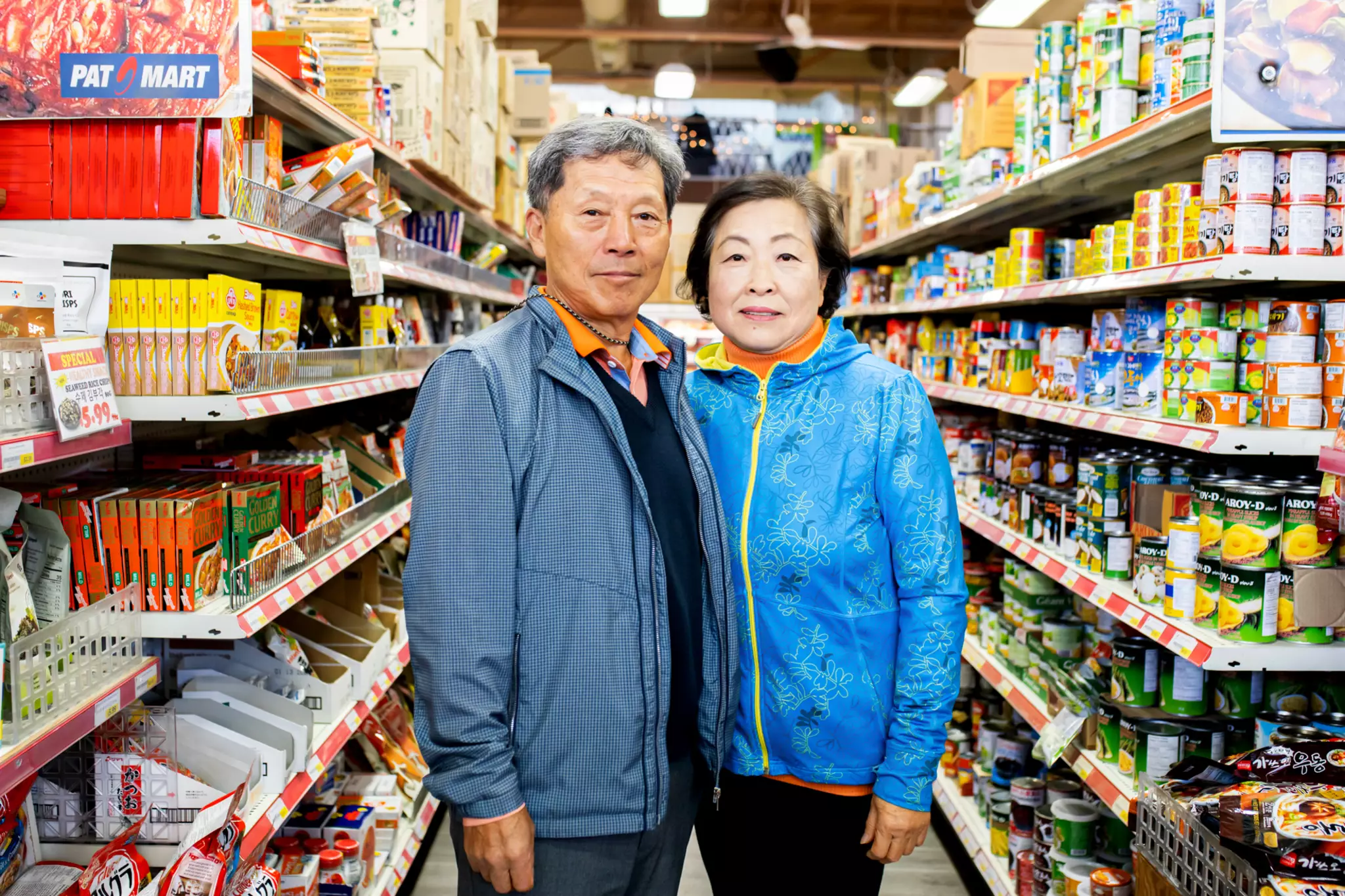Open Wednesday to Saturday, 12 p.m. to 6 p.m.
The Story of Toronto's Jean Lumb
How a Chinese-Canadian woman supported her family and community, saved Toronto’s Chinatown from demolition, and taught the Prime Minister how to use chopsticks.
Previous slide
Next slide
Toronto Star Photograph Archive, Courtesy of Toronto Public Library & Jean Lumb Foundation
Some may not know that under Nathan Phillips Square and City Hall is the original site of Toronto’s Chinatown. The first of many Chinatowns, the cultural enclave was located amid the bustling suburb of the Ward, Toronto’s earliest immigrant settlement. While two-thirds of Chinatown was demolished for the construction of Nathan Phillips Square and City Hall in 1965, the rest of the neighbourhood was still at risk.
In response, a well known community leader and restaurateur, Jean Lumb, founded and chaired the Save Chinatown Committee. The committee’s work led to the preservation of Chinatown in 1969 to prevent further demolition. The City limited buildings to four storeys, allowing the remainder of Chinatown to survive and eventually move West to Spadina to become what we know as Chinatown today. Jean would later travel to Vancouver and Calgary as the only woman representative to help save Chinatowns in these cities as well.

Jean Lumb (née Toy Jin Wong) (b.1919, d. 2002) was a Chinese-Canadian woman whose activism and dedication to her community ultimately shaped Toronto’s Chinatown and the rights of Chinese people in Canada. Her story shows us the importance of community advocacy, and how food can play a role in building meaningful cross-cultural connections among Torontonians.
Much of Jean’s youth took place in fruit markets, as she worked in her father’s Vancouver store. At age 12, Jean stopped going to formal school (which at the time, was segregated for Chinese students) to work full time and allow her older brother, Robert, to attend high school. This sacrifice did not go unappreciated. Robert used this opportunity to continue his education and become an aeronautical engineer, later training pilots during WWII and on the Toronto Islands.
Years later, Jean left Vancouver to help her older sister’s fruit market in Toronto. Jean sat on a wooden train bench for 4 days and 3 nights. Her food for the journey consisted of a loaf of bread, a ham, and $1 to buy a drink. Little did Jean know, it is in Toronto that she would become a prominent Chinese businesswoman and organizer. At 17 years old, soon after arriving in Toronto in 1935, Jean opened up her own fruit market at Bathurst St. and St. Claire Ave. Jean was later introduced to her husband, Doyle, who ran the store with her until opening their restaurant, Kwong Chow Chop Suey House, in 1959 on Elizabeth St.

Kwong Chow was a second floor Cantonese eatery that hosted Chinese and non-Chinese customers alike, including Prime Ministers, politicians, and movie stars. Kwong Chow was one of the first restaurants in Toronto to serve dim sum. Jean shared Chinese cooking widely. She would appear and do cooking demonstrations on TV, on the radio, at department stores, and in institutions such as the Royal Ontario Museum. For Jean, food was not only a means of sustenance, but a method of expressing culture and sharing it with others.
It is at Kwong Chow that Jean hosted Prime Minister John Defienbaker, Mayor Nathan Phillips, and Chinese organizers to discuss issues facing Chinese people in Toronto. When Defienbaker was struggling with his chopsticks, she lended a hand. This was not Jean’s first encounter with Prime Minister Defienbaker, as she spent a large portion of her life involved in politics, fighting discriminatory policies against Chinese people and culture.
Jean’s father, mother, and husband all had to pay $50, $100, and $500 respectively when immigrating to Canada. This was because of the Chinese Head Tax, which was created to discourage Chinese people from coming to Canada starting in 1886. This was followed by the Chinese Exclusion Act passed in 1923, which stopped all Chinese immmigration to Canada for 23 years.
This discriminatory immigration act ended in 1947; however, policies rooted in racism remained that kept Chinese families separated. Only Canadian citizens could bring family members in China to Canada, and they had to be parents older than 65 or children under 18 years old. This stopped wives from reuniting with their husbands, causing Chinatown to be predominantly a bachelor community. Jean and others would not stand for the separation of Chinese families.
In 1957, over 20 Chinese Canadians from across the country travelled to Ottawa to speak to Prime Minister Diefenbaker about changing these immigration laws. Among them was Jean, the only woman delegate in attendance. Foon Sien was the group’s spokesperson and sat on one side of the Prime Minister, Jean was asked to sit on the other. Throughout the presentation, Diefenbaker would ask Jean what Foon Sien was saying, and Jean would repeat and clarify.
“The questions from the floor were mostly directed to me because of the fact that I was a woman and the issue was family reunion…. I feel very lucky that I had the opportunity to be out front as an official spokesperson. Women have always had to be too much in the background.”
Jean Lumb
It was later found out that Diefenbaker had one bad ear, which was on the side that Foon Sien was sitting. Jean was speaking into the Prime Minister’s good ear, ensuring he heard the entire presentation. By 1967, the regulations were revised and immigration restrictions on the basis of race and national origin were removed.
Jean has a long list of accomplishments, many of which were firsts for a Chinese-Canadian, a woman, and a restauranteur. Throughout her life she did extensive work in the Chinese community, including establishing the Chinese Community Dancers of Ontario. She was also the first Chinese-Canadian woman on the Board of Women’s College Hospital. Jean was the first Chinese-Canadian woman and the first restauranteur to be appointed to the Order of Canada (1976). A year later, Jean received the Queen Elizabeth II Silver Jubilee Medal and the Governor General’s Award.
Listen to a Jean Lum theatrical monologue, produced by Museum for its Women of the Ward 2019 Audio Tour
This remarkable woman’s legacy continues long after her passing in 2002. The Jean Lumb Foundation awards high school students with Chinese heritage annually for their accomplishments. You can visit the Jean Lumb plaque in Diversity Garden (southeast corner of Elizabeth St. and Foster Pl.) near the original site of Kwong Chow. You can also walk along Jean Lumb Lane, east of Huron St., extending south of Dundas Street West.
Today, we continue to create meaningful connections over meals. Jean Lumb reminds us that discussions of social change can happen over chop suey, and of the continued importance of Chinese communities thriving in Toronto.
Jean Lumb speaking about coming to Toronto and the Chinatown demolition
EXPLORE FURTHER:
Spirit of the Dragon: The Story of Jean Lumb, a Proud Chinese-Canadian
By Arlene Chan
32 pages. Dundurn, 1997.
The Jean Lumb Foundation Website
The Jean Lumb Foundation is a charitable organization with the mandate to advance education and provide scholarships to high school students of Chinese heritage.
Explore More
There are vibrant hues hiding in unexpected places around the
A Taste of Beekeeping in Toronto
Learn about urban beekeeping, the city's honeybee population, and partake
Share this Article
Explore More
Content
Urban Colour & Natural Dyes Workshop
There are vibrant hues hiding in unexpected places around the city! Learn the art of creating dyes with the Contemporary Textile Studio Co-Op
A Taste of Beekeeping in Toronto
Learn about urban beekeeping, the city's honeybee population, and partake in a honey tasting!
Conversations on Toronto’s Don River Redevelopment
What is the future of Toronto's iconic Don River?
Mushrooming, Foraging & Native Pollinator Gardens in Toronto
Uncover how Toronto's unique world of plants and mushrooms is right at your fingertips
Untold Stories of Toronto’s Waterfront: A Talk with Author M. Jane Fairburn
A unique talk that invites you to rediscover the past, present and future of life along Toronto's waterfront.
Urban Forest Bathing: A Guided Meditation Session
Come downtown to discover nature blooming through the concrete! Join us for an urban forest bathing experience.
Myseum of Toronto Changes Its Name to ‘Museum of Toronto’
Myseum of Toronto Changes Its Name to ‘Museum of Toronto’ The Museum of Toronto is Toronto’s City Museum Toronto, ON (April 2, 2024) Today, Myseum of Toronto announced it will
Protected: TGW Preview
There is no excerpt because this is a protected post.
Press Releases and Media
Press Releases and Media Museum of Toronto Recent Press Releases Find Usin the News
PAT Market: A Torontonian Grocer and Koreatown Staple
As a landmark independent grocery store, PAT continues to bring Torontonians together over a love for food and a commitment to serve their local community.










